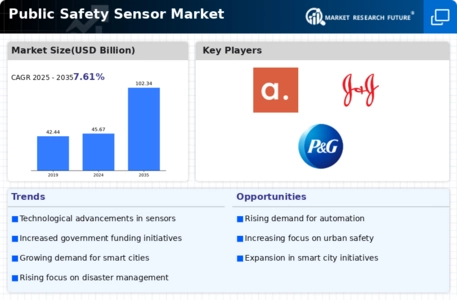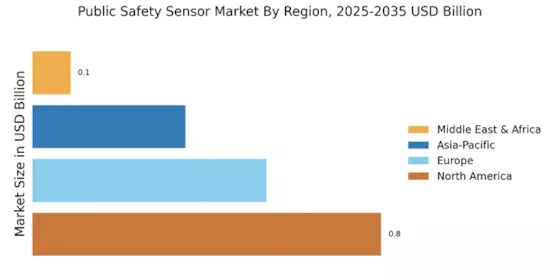Rising Crime Rates
The rising crime rates in various regions appear to be a driving force behind the demand for public safety solutions, thereby impacting the Public Safety Sensor Market. As crime statistics indicate an upward trend in certain urban areas, there is an increasing urgency for law enforcement agencies to adopt advanced technologies to combat these challenges. The integration of public safety sensors, such as surveillance cameras and motion detectors, can enhance situational awareness and facilitate quicker responses to incidents. Recent reports suggest that cities with higher crime rates are more likely to invest in public safety technologies, which could lead to a robust growth trajectory for the Public Safety Sensor Market. This trend underscores the necessity for innovative solutions to address public safety concerns effectively.
Increasing Urbanization
The trend of increasing urbanization appears to be a significant driver for the Public Safety Sensor Market. As urban areas expand, the need for enhanced public safety measures becomes more pronounced. Urban environments often face challenges such as higher crime rates and increased traffic incidents, necessitating the deployment of advanced sensor technologies. According to recent data, urban areas are projected to house over 68% of the world's population by 2050, which could lead to a heightened demand for public safety solutions. This urban growth may compel municipalities to invest in smart city initiatives, integrating public safety sensors to monitor and respond to emergencies more effectively. Consequently, the Public Safety Sensor Market is likely to experience substantial growth as cities seek to ensure the safety and security of their residents.
Technological Advancements
Technological advancements in sensor technologies are likely to propel the Public Safety Sensor Market forward. Innovations such as improved sensor accuracy, enhanced connectivity, and the integration of artificial intelligence are transforming the landscape of public safety solutions. These advancements enable real-time data collection and analysis, allowing for more informed decision-making by public safety officials. The emergence of smart sensors that can detect various environmental factors, such as air quality and noise levels, is also contributing to the evolution of public safety measures. As technology continues to advance, the Public Safety Sensor Market is expected to witness increased adoption of these sophisticated solutions, ultimately leading to enhanced safety and security for communities.
Government Initiatives and Funding
Government initiatives and funding aimed at enhancing public safety are likely to play a crucial role in the growth of the Public Safety Sensor Market. Various governments are increasingly recognizing the importance of investing in public safety infrastructure, which includes the deployment of advanced sensor technologies. For instance, funding programs and grants are being established to support local law enforcement agencies in acquiring state-of-the-art public safety sensors. In recent years, several countries have allocated significant budgets for public safety enhancements, which could lead to a surge in sensor adoption. This financial backing may facilitate the integration of innovative technologies, such as AI and machine learning, into public safety systems. As a result, the Public Safety Sensor Market is expected to benefit from these governmental efforts, fostering a safer environment for communities.
Public Awareness and Community Engagement
Public awareness and community engagement regarding safety issues are emerging as vital drivers for the Public Safety Sensor Market. As communities become more informed about safety challenges, there is a growing demand for effective solutions to address these concerns. Initiatives aimed at educating the public about the benefits of public safety sensors can lead to increased acceptance and support for their implementation. Furthermore, community engagement in safety programs often results in collaborative efforts between residents and local authorities, fostering a sense of shared responsibility. This heightened awareness may encourage municipalities to invest in public safety technologies, thereby stimulating growth in the Public Safety Sensor Market. As communities prioritize safety, the demand for innovative sensor solutions is likely to rise.

















Leave a Comment